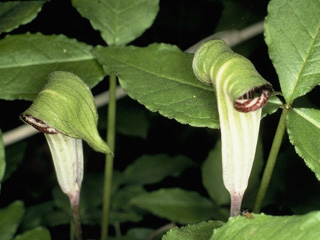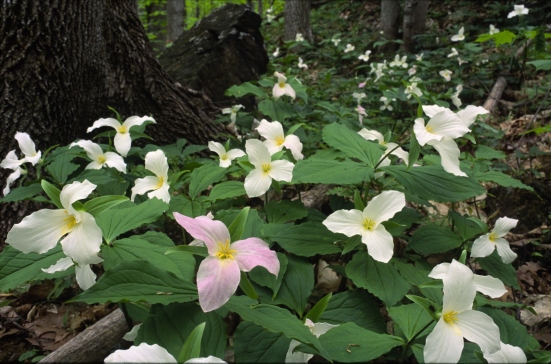by Master Gardener Tammy Borden
I love the time of year when the forest floor is alive with color. Mid to late spring is the prime time for native woodland flowers to shine. The leaves from deciduous trees haven’t fully emerged yet, allowing the sun to penetrate through to the ground, warm- ing the layers of dead leaves that have accumulated through the years to create a rich soil with lots of organic matter. The sun also beckons many woodland blooms to push through.
Don’t have a forest in your backyard? No worries! You can still grow many woodland natives. Here are some of my favorites that have done well for me in my shade garden.
Jack in the Pulpit (Arisaema triphyllum) Member of the Arum family. Prefers moist soil. An exotic looking plant with a hooded flower or “pulpit.” The leaves can resemble those of Trilliums, but are generally larger and have deeper veining. The flowers produce a cluster seed head which turns a brilliant red in fall.
Yellow Trout Lily (Erythronium americanum) Member of the lily family. Can tolerate dry shade. Nodding yellow 1″ flowers. The leaves have a beautiful mottled appearance that is said to resemble the coloring of a brown trout, from which it receives its ” name. Do not allow tuberous bulbs to dry out when planting. Be patient – they can take from 4-7 years to bloom from seed.
Smooth Solomon’s Seal (Polygonatum biflorum) Member of the lily family. Can tolerate dry shade. Long arching stems produce small inconspicuous light green blooms along the stem that hang below the leaves. When its stalk breaks away it leaves a distinctive mark that is said to resemble the seal of King Solomon, from which it derives its name.
Virginia Bluebell (Mertensia virginica) Member of the borage family. Prefers moist soil. Can also tolerate morning sun. Also called lungwort. Foliage will die down by mid-summer. Beautiful groups of bell-like flowers that start off pink then change to light blue. Hybridized versions available.
Wild Columbine (Aquilegia canadensis) Member of the buttercup family. Can tolerate dry, rocky soil. One of the most stunning woodland flowers, in my opinion. It was once considered for our national flower because the shape of its orange and yellow flowers resemble the talons of a bald eagle. Aquilegia is Latin for “eagle.” Loved by hummingbirds and sphinx moths. Many hybridizes versions are available.
Trillium (Trillium Grandiflorum) Member of the lily family. Prefers consistently moist soil. Large pure white three-lobed flowers that fade to pink. Some unique hybrids are also available featuring purple flowers, versus the white three lobed flowers commonly seen. Seeds are dispersed by ants that carry them into their nest, but don’t eat them.
Be sure to purchase woodland flowers from a reputable nursery that has not cultivated their plants from wild stock. It is illegal to dig up many woodland native species. Seed collection, however, is a wonderful way to preserve and propagate your own plants.



Yes, exactly…always another surprise overtime you turn your head, right? 🙂 Your trilliums are magical discoveries.
LikeLike